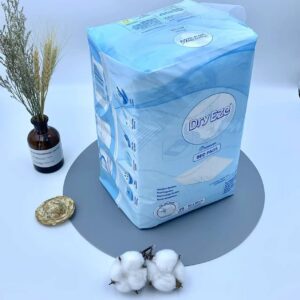Underpads help protect mattresses and furniture from moisture, spills, and stains by providing a barrier that absorbs and contains liquids, preventing them from reaching and damaging the underlying surfaces. Here’s how they work:
- Absorbency: Underpads are designed with multiple layers of absorbent materials, such as fluff pulp or super-absorbent polymers, in the core. These materials can quickly soak up liquids, turning them into a gel-like substance and preventing them from spreading.
- Moisture Barrier: The bottom layer of the underpad is typically waterproof or moisture-resistant. This layer prevents liquids from passing through and reaching the mattress or furniture, effectively containing the moisture within the pad.
- Wicking Action: Underpads are constructed with a wicking or transfer layer that helps distribute moisture evenly across the absorbent core. This prevents pooling of liquids and promotes efficient absorption.
- Securement: Many underpads have features like adhesive strips, tuck-in flaps, or elasticized corners that help keep them securely in place on the mattress or furniture, reducing the risk of displacement during use.
- Size and Coverage: Underpads come in various sizes, including those suitable for cribs, beds, and chairs. Choosing the right size ensures adequate coverage and protection for the specific area.
- Disposable or Reusable: Users can select between disposable and washable/reusable underpads based on their preferences and needs. Disposable underpads are discarded after use, while washable underpads can be laundered and reused multiple times.
- Odor Control: Some underpads are designed with odor control features to help minimize unpleasant smells associated with moisture.
- Versatility: Underpads are versatile and can be used for a range of purposes, including managing incontinence, protecting bedding during potty training, and providing a clean surface for diaper changes.
- Easy Replacement: When an underpad becomes soiled, it can be quickly and easily replaced with a fresh one, reducing the need to clean and sanitize the mattress or furniture.
Overall, underpads are a convenient and effective solution for protecting mattresses and furniture from moisture-related damage, stains, and spills. China Underpad supplier They are widely used in healthcare settings, as well as in home care, to maintain hygiene and comfort for individuals with incontinence or other moisture-related needs.
What is the typical composition of underpads, including the layers and materials used for moisture absorption and protection?
Underpads typically consist of multiple layers with specific materials that provide moisture absorption and protection. Here’s the typical composition of underpads:
- Top Layer (Facing Layer): This is the layer that comes in contact with the user’s skin. It is usually made of a soft, non-woven fabric that is gentle and comfortable to the touch. The top layer is designed to wick moisture away from the skin to keep the user dry and comfortable.
- Absorbent Core: The absorbent core is the central layer responsible for soaking up and retaining moisture. It is often composed of one or more of the following materials:
- Fluff Pulp: Fluff pulp is a soft, fibrous material made from wood pulp. It is highly absorbent and quickly turns liquid into a gel-like substance, preventing leakage.
- Super-Absorbent Polymers (SAP): Super-absorbent polymers are substances that can absorb and retain a significant amount of liquid. They are often combined with fluff pulp to enhance absorbency.
- Moisture-Resistant or Waterproof Layer: This layer is located at the bottom of the underpad and serves as a barrier to prevent moisture from passing through and reaching the underlying mattress or furniture. It is typically made of waterproof polyethylene or a similar moisture-resistant material.
- Wicking or Transfer Layer: Some underpads include an additional layer designed to distribute moisture evenly across the absorbent core. This layer promotes efficient absorption and helps prevent pooling of liquids, ensuring even coverage.
- Backing Layer: The backing layer provides additional protection and durability. It is often made of a non-slip, moisture-resistant material to keep the underpad in place and prevent it from shifting during use.
- Adhesive Strips or Tuck-In Flaps (Optional): Many underpads have adhesive strips, tuck-in flaps, or elasticized corners that help secure the underpad to the mattress or furniture, reducing the risk of displacement.
- Odor Control (Optional): Some underpads are designed with odor control features, such as a layer containing odor-neutralizing compounds to minimize unpleasant smells associated with moisture.
- Size and Shape: Underpads come in various sizes and shapes to accommodate different uses, including bed-sized underpads and smaller chair-sized or changing table-sized underpads.
The combination of these layers and materials ensures that underpads effectively absorb and contain moisture, protecting mattresses, furniture, and surfaces from stains and damage. The choice of underpad composition may vary based on the specific brand and product line.

